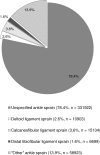Incidence of ankle sprains among active-duty members of the United States Armed Services from 1998 through 2006
- PMID: 20064045
- PMCID: PMC2808751
- DOI: 10.4085/1062-6050-45.1.29
Incidence of ankle sprains among active-duty members of the United States Armed Services from 1998 through 2006
Abstract
Context: Ankle sprains have been reported as one of the most common injuries sustained by members of the US Armed Services. However, little is known about the incidence rate and injury patterns associated with ankle sprains in this population.
Objective: To examine the incidence of ankle sprains among active-duty members of the US Armed Services from 1998 through 2006. A secondary objective was to describe the sex, age, and service-specific injury patterns in this young, physically active population.
Design: Cohort study.
Patients or other participants: All active-duty service members from the day they enter military service until the day they leave military service and US Army Reserve and National Guard service members during periods of active duty and mobilization.
Main outcome measure(s): Injury data were extracted from the Defense Medical Epidemiological Database from 1998 through 2006. All data for ankle sprains, coded according to the International Classification of Diseases (9th revision), were included. Cases were limited to those injuries reported as first occurrences. Incidence rates (IRs) were calculated per 1000 person-years by sex, age, and service. Incidence rate ratios (IRRs) and 95% confidence intervals (95% CIs) were used to assess the strength of association between the incidence of ankle sprain and the independent variables of sex, age, and service.
Results: From 1998 through 2006, 423 581 service members sustained ankle sprains and 12 118 863 person-years at risk to injury were documented in this population. The incidence rate was 34.95 (95% CI = 34.85, 35.06) per 1000 person-years at risk. Females were 21% more likely (IRR = 1.21, 95% CI = 1.21, 1.23) to sustain an ankle sprain than males. Sex-specific IR varied by age and service. Differences in the rate of ankle sprains were also noted by age and service.
Conclusions: The incidence of ankle sprains among US service members was 5 times greater than that previously reported in civilian population studies. Sex, age, and branch of military service are important factors related to the incidence of ankle sprains in this population.
Figures
References
-
- Lauder T. D., Baker S. P., Smith G. S., Lincoln A. E. Sports and physical training injury hospitalizations in the Army. Am J Prev Med. 2000;18(suppl 3):118–128. - PubMed
-
- Davidson P. L., Chalmers D. J., Wilson B. D., McBride D. Lower limb injuries in New Zealand Defence Force personnel: descriptive epidemiology. Aust N Z J Public Health. 2008;32(2):167–173. - PubMed
-
- Strowbridge N. F., Burgess K. R. Sports and training injuries in British soldiers: the Colchester Garrison Sports Injury and Rehabilitation Centre. J R Army Med Corps. 2002;148(3):236–243. - PubMed
-
- Knapik J. J., Sharp M. A., Canham-Chervak M., Hauret K., Patton J. F., Jones B. H. Risk factors for training-related injuries among men and women in basic combat training. Med Sci Sports Exerc. 2001;33(6):946–954. - PubMed
-
- Ferran N. A., Maffulli N. Epidemiology of sprains of the lateral ankle ligament complex. Foot Ankle Clin. 2006;11(3):659–662. - PubMed
MeSH terms
LinkOut - more resources
Full Text Sources
Medical



